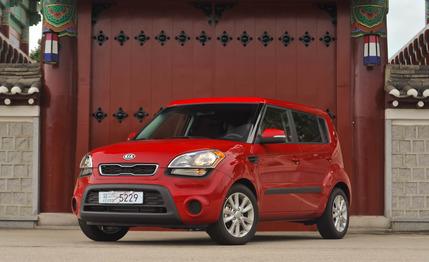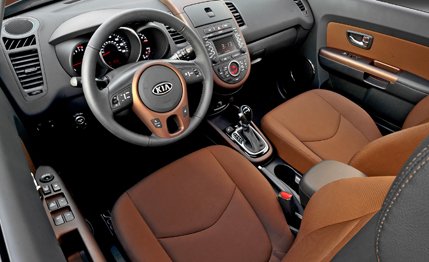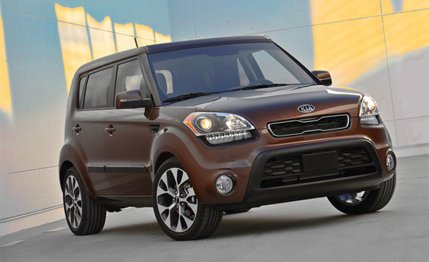 First Drive Review
First Drive Review
What Is It?
It’s a very subtly refreshed Kia box. With the Soul only in its third year of production, Kia has addressed what it admits was the car’s main weakness by way of two upgraded engines and new transmissions.
First, the important part: The base 1.6-liter four-cylinder now makes 138 hp and 123 lb-ft of torque, up from 122 and 115, thanks to the addition of direct injection. The Soul’s 2.0-liter four now makes 164 hp and 148 lb-ft, increases of 22 hp and 11 lb-ft. Six-speed manual and automatic transmissions replace a pair of five-speed sticks and a four-speed auto. The new transmissions help to increase the Soul’s EPA fuel economy with the 1.6-liter from last year’s 26 mpg city/31 highway with either transmission to 27/35; the 2.0’s ratings rise from 24/30 to 26/34.

Allow us to point out the styling changes. The pug face’s lower fascia has been revised with a wider trapezoidal lower lip and larger fog lamps. Out back is a similarly new, wider-looking fascia below the liftgate. Top-of-the-line Soul Exclaim (Kia wants us to put an italicized exclamation mark there, but we refuse) models now include LED daytime running lights and taillights. And that’s about it.
How Does It Drive?
In a pretty familiar manner. The sole Soul we drove in and around Seoul was a 2.0-liter with the automatic. It had plenty of power for passing maneuvers on South Korea’s well-maintained highways. The six-speed auto is a vast improvement over the four-speed. It shifts quickly—although we did note a slight delay during some downshifts—and its taller final-drive ratio keeps the engine quieter (and more efficient) when cruising. Those Souls with the upgraded 1.6-liter should perform similarly to the outgoing 2.0-liter models, which hit 60 in 7.9 seconds; the revised 2.0-liter should be good for a 0-to-60 time in the low 7s.
Although we didn’t sample it on a Soul, Kia did allow us to drive a 2012 Rio5 equipped with its “idle stop and go” (ISG) system. ISG is a simple, unobtrusive stop/start system for auto-equipped cars. It turns off the engine when the load permits at a standstill and fires it back up when your foot comes off the brake pedal. Later this year, we will get a Soul Eco, which will bundle ISG with low-rolling-resistance tires and an active-eco setting that dulls throttle response. Eco Souls will see fuel mileage increase to 29/36 with the 1.6-liter and 27/35 with the 2.0. Manual buyers will have to exercise their key wrists to see similar gains.

How Does It Stack Up?
Kia’s entry remains our choice in the boxy little hatchback segment, facing off as it does against the Nissan Cube and Scion xB. (In case you’re wondering, the Honda Element is dead for 2012.) The Soul’s newfound power solidifies that position. Plus, the Soul comes in brown, with an optional two-tone interior whose trim pieces and seat inserts remind us of frozen Coke. Delicious frozen Coke. Newly available equipment for 2012 includes Kia’s Uvo infotainment system and an Infinity sound-system upgrade.
What’s the Cost?
Much to no one’s surprise, Kia has kept the 2012 Soul’s price pretty close to that of last year’s model, with stickers seeing an increase of $600 to $800. A base Soul with the 1.6 and a manual starts at $14,650, with the automatic adding $1800 to the price. The Soul Plus starts at $17,050 and includes more equipment, including the 2.0-liter; an auto costs an extra grand here. The top-spec Exclaim is auto-only and runs $20,350. The Sport model, with its unique suspension tune, dies off for 2012.
So that’s more power, better efficiency, and basically the same price, all in the same useful, packaging-focused little hatch. Planned obsolescence with no real downside.